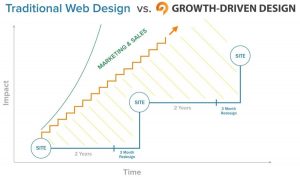Empowering teams to analyze their current work can uncover bottlenecks that help everyone work more efficiently to complete projects.
If you’re a marketing team that’s been caught up in a process that’s preventing you from getting work out the door quickly, you may have a flow problem.
A flow problem is when your company’s internal processes are causing a traffic jam and a lot of marketing work gets started, but somewhere along the line it gets halted – often due to dependencies on sign-offs by management or Legal, or other external dependencies.
Kanban is an agile framework that’s used by a lot of marketing teams. Some benefits of Kanban for marketers include:
- Delivers value to customers’ more quickly.
- Drives innovation and ownership of work by the team.
- It’s the easiest agile framework for getting started.
Start with what you know
The reason that Kanban is the easiest framework for marketers to begin with is that one of its principles is “start with what you do now.” There’s no need to carve out new roles for Kanban or to re-organize people – at least not in the beginning.
Kanban is all about getting the people who are closest to the work to analyze their current way of working to discover where the bottlenecks are occurring in the workflow.
A marketing team I worked with discovered that their bottleneck was the VP of Marketing who needed to sign-off on work. Because he was one person, delivery dates could often be held up by several days or weeks, depending on his availability.
The team grouped various work items by item type to measure the flow. The different item types were press releases, social media and sales presentations. They learned that sales presentations got held up in the flow the most, so they focused their efforts on removing the log jams there first.
Pursue evolutionary change
A lot of people think they’re doing Kanban if they have a “Kanban board,” but that’s just one part of the framework. The biggest piece is the idea that people at all levels of the organization are empowered to pursue evolutionary change.
Evolutionary change is a pretty powerful thing! It’s not just saying a team member is going to have an idea and then wait for management to do something about it.
Evolutionary change means that the team isn’t going to settle for “this is how we’ve always worked.” The organization needs to encourage and embrace the team to pursue real, meaningful changes that vastly improve the way their workflows.
For the marketers I worked with, they were able to show their VP how work was getting stuck in his queue and asked what they needed to do to gain his trust. While he wasn’t willing to forgo sign-offs on everything right away, he was willing to let the team sign off on some of the less risky items.
For Kanban to work, the team needs to continue proving that it can improve its flow through changing the current system. This may not happen overnight, but it requires both the team and the leaders to embrace this mindset.
Limit work in progress
Most marketers I know are plagued with too much work in process. We’ve turned our industry into ‘more is better’ and we’re rewarded based on how many pieces of content we can produce, rather than the value each one brought to our customers.
Kanban is all about limiting work in progress and getting things done rather with quality rather than piling on more and more projects.
A Kanban team determines its work in progress limit (WIP) based on how work is flowing for them. If the team experiments with two as its WIP, it may have team members sitting idle. It’s pretty rare though to find a team with a WIP that’s too low. Typically, we have way too much WIP! If a team sets its WIP to 10, it may find that a lot of those items get stuck. The team then may discover that 5 is the right number for them, enough to keep the team busy, but most items are able to flow through the system quickly.
By limiting work in progress, marketers can focus on completion and responding to customer feedback.
If a team was responsible for social media, it’s natural for them to work individually, starting as many things as they can at once. With Kanban, the team resets to focus on finishing, even if it means people do things that aren’t normally their job to get the work done.
Here’s what this may look like in practice:

When we realize that work has zero value until it’s in the hands of customers, we can focus on finishing rather than starting.
Getting started with Kanban is easy! Just make sure that the leaders are able to empower the team to pursue evolutionary change and to focus on finishing work rather than starting a lot of things.
Opinions expressed in this article are those of the guest author and not necessarily Marketing Land. Staff authors are listed here.
Marketing Land – Internet Marketing News, Strategies & Tips
(54)
Report Post







